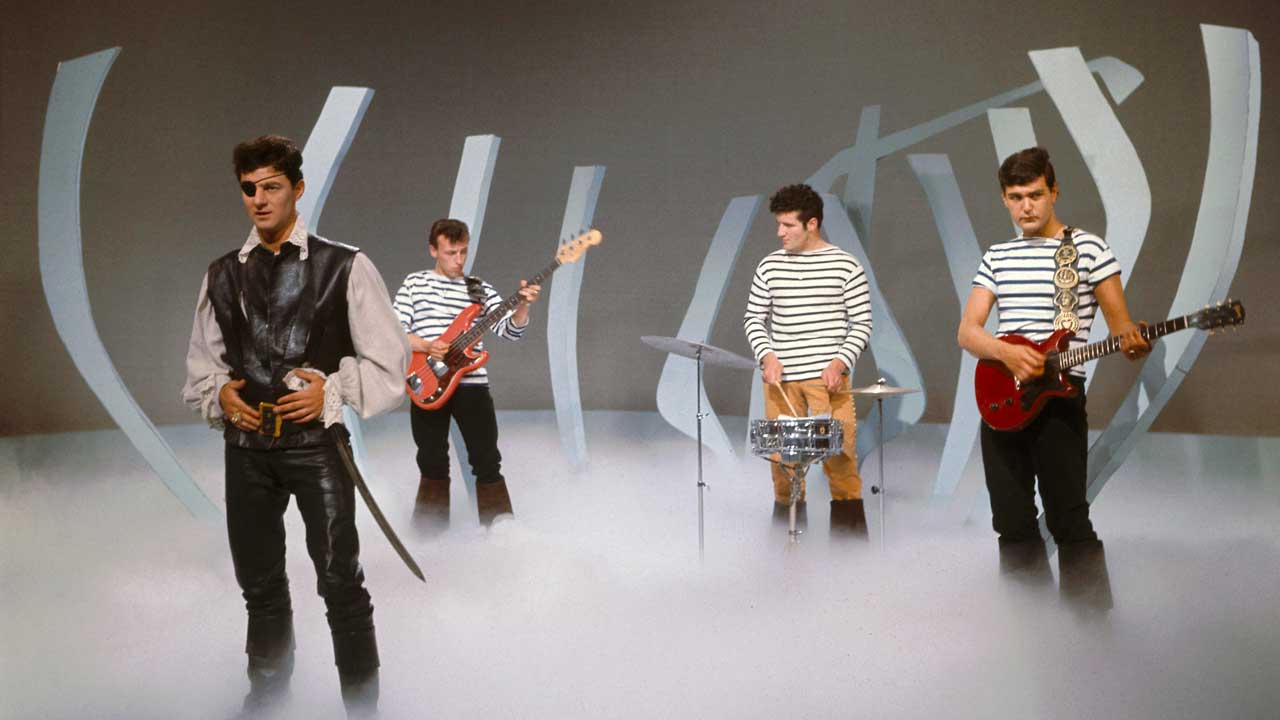
It’s a curious fact that some of the most enduring songs were written in a matter of minutes, such as The Beatles’ Yesterday, the Stones’ Satisfaction, Led Zeppelin’s Rock And Roll and Black Sabbath’s Paranoid. Another one is Johnny Kidd & The Pirates’ classic from 1960, Shakin’ All Over. Knocked together hastily in a cellar at midnight, it was intended as a throwaway B-side. Instead it became a monster hit and a foundation stone of British rock‘n’roll.
“I’d asked our studio engineer, Peter Sullivan, if we could write the B-side of our next single,” explains bassist Brian Gregg. “But we were so busy doing gigs that we never got round to writing it until the night before the recording session at Abbey Road. We got back to London at midnight, after a gig in Aylesbury, and Alan Caddy [guitarist], myself and Johnny Kidd went to the Freight Train coffee bar in Soho. Downstairs was an unused basement with no lighting, full of old chairs and CocaCola crates. All our instruments were still outside in the van, so the three of us sat there and came up with the guitar intro and bass line.”
All they needed were some lyrics. Then Kidd had an idea.
“He had a part of his stage act called dynamic tension,” says Gregg. “Johnny would hold himself really stiffly and then shake during the guitar solo. So he told us he’d like to do a song where he could do this routine, because it used to go down really well with the girls. Suddenly we had Shakin’ All Over as a title, and started slotting words in between these two riffs. We were a bit ashamed of it, to be honest, because by 1960 the term ‘shakin’’ was so passé; Jerry Lewis had already done Whole Lotta Shakin’ Goin’ On and Bill Haley had covered Shake, Rattle And Roll. But we thought: ‘Oh well, it’s tucked away on a B-side, so it won’t bloody matter.’”
The band still hadn’t played Shakin’ All Over by the time they arrived at Abbey Road at 10.30 the next morning. The main focus of the session was the A-side, Yes Sir, That’s My Baby, an American standard that their label EMI had insisted they cover. Luckily, they were given a little extra time to work up Shakin’ All Over, due to another artist running late in their studio. Repairing to the canteen, the Pirates were joined by guitarist Joe Moretti, who they’d called in to play lead.
“It wasn’t that Alan Caddy wasn’t capable of doing it,” states drummer Clem Cattini. “But he had this nervousness in the studio, so we got Joe in to do the solo. It just came out off the top of his head. Once we got in there, we had a little run through and that was it.”
Shakin’ All Over was nailed by the second take, and the finished item was extraordinary. Led off by a goose-bumpy riff and Gregg’s equally memorable bass line, with Kidd’s lust-ridden protagonist quaking into the chorus, it was quintessential rock’n’roll drama. The use of echo, allied to Cattini’s drum fill and Moretti’s solo, heightened the effect.
“Wally Ridley gets credited as producer on Shakin’ All Over, but he wasn’t even there when we did it,” reveals Cattini. “It was Peter Sullivan, Wally’s assistant. There was a bare room at the back that you could use as an echo chamber, and that’s how we got the atmosphere on the record.”
Gregg adds: “Clem went into this drum break and ended up doing two bars instead of one, but Peter said: ‘That doesn’t matter. I like it. That long drum break gives it a feeling of anticipation, like something is about to happen.’ And he was right.”
Sullivan also recognised a hit when he heard one, and immediately advised EMI to promote it to the A-side. It was left to influential TV producer Jack Good to green-light his suggestion.
“EMI sent him the single,” says Gregg. “Jack hated Yes Sir, That’s My Baby – as we all did – but he thought Shakin’ All Over was fantastic. Then he booked us on to Wham!, his current show, and it just took off.”
“Next thing we knew,” says Cattini, “the single was zooming up the charts."
Shakin’ All Over reached the top spot in the UK in August 1960, making a huge star of the charismatic Kidd. Wearing his trademark eye patch, he and the band – all decked out in pirate gear – were a live sensation, a precursor to the advent of theatrical rock.
“We used to go down an absolute storm,” Cattini recalls. “Johnny was so popular, not only with girls but with guys as well. I don’t think he ever really got the credit he deserved.”
“Johnny Kidd was such an exciting guy on stage,” adds Gregg. “Freddie Mercury reminded me of him very much. They had the same style, the attitude was so similar.”
Tragically, Kidd died in a car crash in Lancashire in 1966, aged just 30. His legacy lives on in a number of distinguished recordings, none more so than Shakin’ All Over. Among those who’ve covered the song over the years are Led Zeppelin, David Bowie, Iggy Pop, The Guess Who, Tom Petty, Van Morrison and The Who. The latter, called the The Detours in the early 60s, had supported Johnny Kidd & The Pirates in late 1962 and early ’63.
“The three true British rock’n’roll records were Cliff Richard’s Move It, Brand New Cadillac by Vince Taylor and Shakin’ All Over,” asserts Gregg. “A lot of bands copied us afterwards. Roger Daltrey gave up guitar and became The Who’s lead singer, because they wanted a trio behind him to get the same sound as us. Led Zeppelin had the same set-up too. Jimmy Page had been with Neil Christian & The Crusaders, who were often our support band when we played locally to London. He used to stand at the side of the stage and watch our every move. I remember Jimmy saying to me: ‘One day I’m gonna have a band like this.’”







